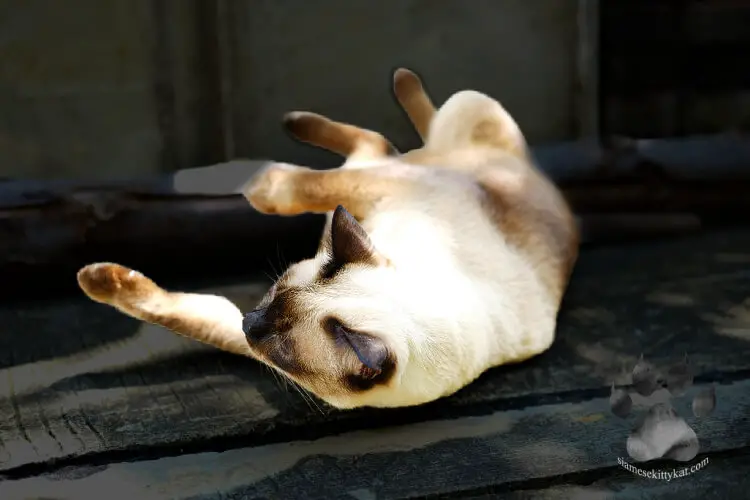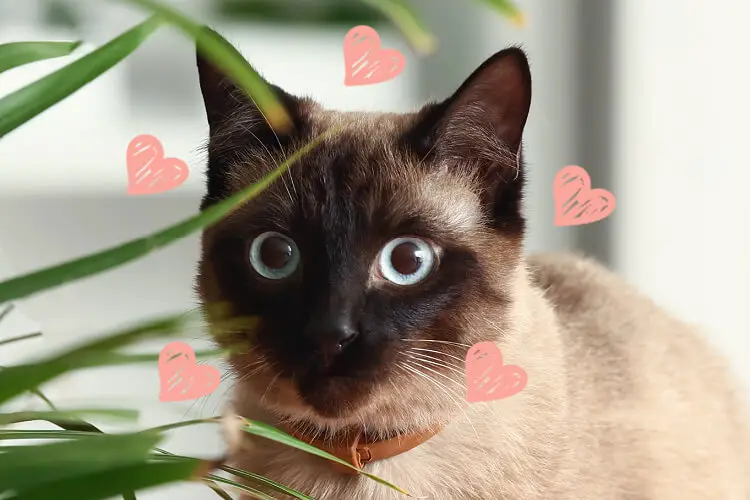If you’re a fan of the Siamese breed, then you might be familiar with the seal point Siamese.
The Seal Point Siamese has dark points and a light body. The breed gets its name from its coloring, which is like a seal.
In this article, we’ll explore the origins of the seal point Siamese and find out why it’s so popular.
What is a Seal Point Siamese Cat?
You may have seen pictures of Siamese cats and think they’re regular cats with pointy ears. But there’s much more to these cats than meets the eye. Siamese cats are one of the oldest breeds in the world and have a long and interesting history.
But what about seal point Siamese cats? What makes them different from other Siamese cats? Seal point Siamese cats are Siamese cats with seal point coloring. Seal point Siamese cats have deep seal brown points on their bodies, with a lighter fawn body color.
The Seal Point Siamese is a medium-sized cat that weighs between 7 and 12 pounds. The breed has a long, elegant body, and its coat is short, smooth, and glossy. The Seal Point Siamese is an intelligent cat breed with a playful and curious nature.
Are All Siamese Cats Seal Point?
No, not all Siamese cats are seal point. In fact, several types of Siamese cats have different colors and patterns. The most common type of Siamese cat is the seal point. But there are also chocolate point, blue point, and lilac point.
Are Seal Point Cats Expensive?
While they are not the most expensive type of cat, they can still be pricey. Depending on the breeder, you can expect to pay anywhere from $600 to $1,200 for a seal point kitten.
Are Seal Point Cats Friendly?
Yes, they are. This surprises many people who think Seal Point Siamese cats rarely tolerate people. But they’re actually sweet and loving.
This cat enjoys the company of other cats and family members, especially children of all ages.
What is the Average Lifespan of a Seal Point Siamese Cat?
There’s no definitive answer to this question since it can depend on various factors. This might include diet and exercise, or even genetics.
Yet, Seal Point Siamese cats have an average lifespan of 12 to 15 years.
Is a Seal Point Siamese Rare?

There’s a lot of debate on whether seal point Siamese cats are rare. So, what’s the truth? Well, it depends on how you define “rare.”
If you go by the strictest definition of the word, then yes, seal point Siamese cats are rare. This is because they are a recent cat breed compared to others. But, if you’re a bit more relaxed about the definition of “rare,” then no, seal point Siamese cats aren’t that rare. This is because they are becoming popular, and more and more people are looking to own one.
So, there you have it! Whether seal point Siamese cats are rare is up for debate. But one thing is for sure: they are beautiful creatures that make wonderful pets.
Are Seal Point Siamese Cats Purebred?
Yes, Seal Point Siamese cats are purebred. Among the major cat registries that recognize them include:
What Health Problems Do Seal Point Siamese Cats Have?
Seal point Siamese cats are prone to a few health problems, including:
Seal points often have trouble breathing because of their small nasal passages. This can lead to chronic respiratory infections or other respiratory problems. Treatment for respiratory problems usually involves antibiotics and other medications.
Seal point Siamese cats may develop diarrhea, vomiting, or other digestive issues. Treatment for digestive problems usually involves dietary changes and/or medication.
I have a very picky cat that is very particular about what she eats and how much she eats. She is also very sensitive to certain foods, so I am always unsure whether she will be okay with what I serve.
She’s been eating the same food for years, and I’m unsure if she’s getting all the nutrients she needs. I want to ensure that she stays healthy for as long as possible, so I will make some changes to her diet.
Seal Point Siamese cats are susceptible to a condition called progressive retinal atrophy. It is a degenerative eye disease that affects the retina. A combination of genetic and environmental factors causes it. Thus, leading to a loss of vision over time.
The earliest symptoms are subtle changes in their visual behavior. Seal point Siamese cats may develop night vision problems. As the disease progresses, their vision degrades until they lose all sight in one or both eyes.
Seal Point Siamese cats are prone to developing primary open angle glaucoma. Affected cats may develop luxation of the lens. This means that the lens may become displaced from its normal position in the eye. This can lead to decreased vision and even blindness in some cases.
Seal point Siamese cats are prone to pancreatitis. This is a condition in which the pancreas becomes inflamed. This can lead to various health problems. This includes vomiting, diarrhea, and extreme weight loss. In severe cases, it can even be life-threatening.
Suppose you’re a seal point Siamese cat owner, and you notice your cat is having trouble digesting or has been vomiting. In that case, it’s important to take him to the vet for an evaluation.
Seal point Siamese cats are prone to developing lymphosarcoma. It is a cancer affecting the lymph nodes. Lymphosarcoma is a rare cancer but one of the most deadly cancers in cats. It’s also one of the most difficult cancers to treat because it spreads fast. It is often difficult to detect early on.
While these health problems can be serious, most seal point Siamese cats live long, healthy lives with proper care from their owner.
Which Cat Breeds Have a Seal Point Coloration?

The Siamese cats’ seal point coloration is one of the breed’s most iconic and distinctive features. But did you know that there are actually several other cat breeds that also have seal point coloration?
Seal point cats get their name from their deep seal brown “point.” This means darker coloration on their faces, ears, legs, and tails. This contrast between the light body and dark points makes seal point cats striking.
Here are some of the most popular seal point cat breeds:
1. Birman
Origin: Myanmar (Burma)/France, c. 1920
Registries: CFA, FIFe, GCCF, TICA
Weight: 10-18lb (4.5-8 kg)
Grooming: 2-3 times a week
Colors and Patterns: Seal point, blue point, chocolate point, and lilac point
The Birman cat is a beautiful and unique animal that makes an excellent pet for anyone looking for a loving and affectionate companion. Birmans are easy to care for and have gentle temperaments. This makes them ideal for households of all types.
2. Himalayan
Origin: US, 1930s
Registries: CFA, FIFe, GCCF, TICA
Weight: 8-15lb (3.5-7 kg)
Grooming: Daily
Colors and Patterns: Himalayan can have blue, chocolate, cream, lilac, red, or seal points. They can also have tortie or lynx points.
The Himalayan is also known as the Colorpoint Longhair or Exotic Longhair. It is a Persian with Siamese-style color pointing.
Himalayans are born creamy white. They do not develop their color pointed markings until they are fully grown.
They have a much more reserved demeanor than Siamese.
3. Balinese
Origin: US, 1950s
Registries: CFA, FIFe, GCCF, TICA
Weight: 6-11lb (2.5-5 kg)
Grooming: 2-3 times a week
Colors and Patterns: Seal, chocolate, blue, and lilac self colorpoints
The Balinese is a long-haired version of the Siamese cat and is stunning. It has the same slender and graceful build as the Siamese, but its coat is much longer and silkier.
Even though it’s not as loud-voiced as the Siamese, it knows how to get your attention. It also has a strong mischievous streak.
4. Neva Masquerade
Origin: Russia, 1970s
Registries: FIFe
Weight: 10-12lb (4.5-9 kg)
Grooming: 2-3 times a week
Colors and Patterns:
The Neva Masquerade cats come in various colors. These include seal, blue, red, cream, tabby, and tortie.
The Siberian, a kind of forest cat with a long history in Russia, is a colorpoint variation of this breed.
Neva Masquerade is a gorgeous, thick-coated colorpoint cat. The breed has an easygoing attitude.
5. British Shorthair – Colorpointed
Origin: UK, 1800s
Registries: FIFe, GCCF, TICA
Weight: 9-18lb (4-8 kg)
Grooming: Weekly
Colors and Patterns:
These traditional cats come in various point colors. These include blue-cream, seal, red, chocolate, and lilac.
Looking for a friendly, lovable housecat that gets along with kids and dogs? The British Shorthair – Colorpointed is the perfect breed for you! They make great companions and are ideal for families.
6. Ragdoll
Origin: US, 1960s
Registries: CFA, FIFe, GCCF, TICA
Weight: 10-20lb (4.5-9 kg)
Grooming: 2-3 times a week
Colors and Patterns:
Ragdoll cats come in six point colors: seal, blue, chocolate, lilac, red, and cream. Their point colors may be solid, lynx, tortie-lynx, particolored, or tortie.
One of the best things about these cats is their gentle and loving personality.
7. Snowshoe
Origin: US, 1960s
Registries: FIFe, GCCF, TICA
Weight: 6-12lb (2.5-5.5 kg)
Grooming: Weekly
Colors and Patterns: Typical Siamese colors in pointed pattern, with white feet. Blue or seal is most common.
The Snowshoe is known as the Silver Laces for its extended white stockings. It is a breed that developed from crossing Siamese with bicolor American Shorthairs. The focus was on developing colorpoints everywhere but on the feet. This gives the cat a distinct and pretty appearance.
The Cat Fanciers’ Association recognized the Snowshoe in 1974. But other organizations and nations have not yet recognized it as a distinct breed.
Conclusion
If you’re looking for an adorable, cuddly companion, look no further than the Seal Point Siamese cat. Their big blue eyes and beautiful coat are sure to steal your heart. But don’t forget, they need lots of love and attention too.
So if you’re ready to shower your new feline friend with all the love they deserve, then the Seal Point Siamese is the perfect cat.
We gathered all the health tips tailored toward maintaining your Siamese cat’s optimal well-being. Check it out here: Siamese Cat Health: A Complete Guide

